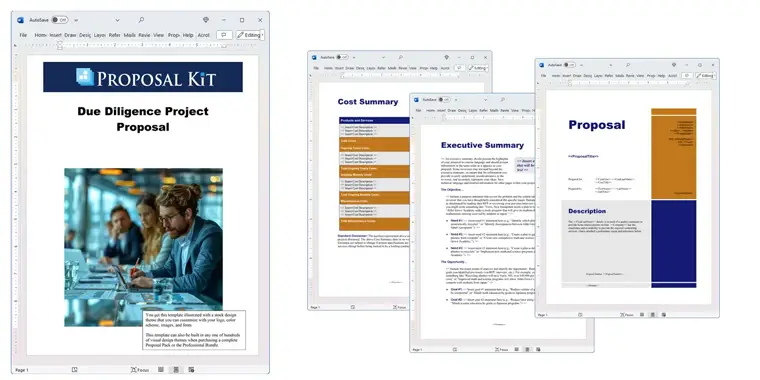How to write your Due Diligence Project Proposal
We include this 22 page layout with every Proposal Pack. If you want this template to have a different visual design theme than the one illustrated here, purchase any Proposal Pack design and create this template using the purchased design theme. This template is included in every Proposal Pack. If you get a Proposal Pack or the Professional Bundle, you can also make any variation of this template with different chapters to suit your needs.
We typically include more chapters in the templates than most people will need to give everyone more variety in the chapters they may need. You can trim down a long template by removing pages you do not need or combining multiple chapter topics into one page.
 DOWNLOADABLE, ONE-TIME COST, NO SUBSCRIPTION FEES
DOWNLOADABLE, ONE-TIME COST, NO SUBSCRIPTION FEES If you need this template on DVD media order from our Amazon shop.
If you need this template on DVD media order from our Amazon shop.
You can also create countless variations of this document to suit your needs using the included library of 2200+ chapters if ordering a Proposal Pack or Pro Bundle.
 What Our Clients Say
What Our Clients SayMany thank for such amazing templates you created for us. I purchased the best for my business."
Related Article
Related Video
Related Templates
- Business Case Document
- Succession Planning Proposal
- Acquisition Plan Proposal
- International Research and Development Project Proposal
- Patenting New Technology Proposal
- Corporate Restructuring Proposal
- Financial Prospectus
- Accounting and Payroll Services Proposal
- Private Eye Investigation Services Proposal
- Bankruptcy and Foreclosure Crisis Report
- Investment Strategy Proposal
- Equity Investment Proposal
- Investment Restructuring to Reduce Risk Proposal
- Tax Preparation Services Proposal
- Popup Kitchen Investment Funding Proposal
- Accounting Services Proposal Template
- PhD Thesis Proposal
- Readiness Assessment Project Proposal
- Investment Management Services Proposal
- Cannabis Medical Supply Business Investment Proposal
- Accounting Proposal Template
- Equity Ownership Stake Proposal
What's the Best Way to Write Your Due Diligence Project Proposal?
A proven way to create a due diligence project proposal is by using the Proposal Kit software and template library. This comprehensive toolkit simplifies the complex task of proposal writing through its user-friendly templates and powerful Wizard software program, which includes a line item quoting database for detailed financial management. Whether you are detailing costs, quotes, estimates, budgets, or other economic aspects, Proposal Kit streamlines the process, making it accessible even for those with no prior experience in proposal writing.
Are you currently tasked with creating a due diligence project proposal and need help figuring out where to start?
What Types of Projects Are Due Diligence Proposals Written For?
Due diligence projects are essential for thorough business analysis before major decisions or investments. Due diligence is a broad topic, so how you structure your proposal and which chapters you include will depend on your situation. Common types of due diligence projects include:
- Merger and Acquisition Analysis: Scrutinizing the details of a potential business merger or acquisition.
- Financial Audit: Conducting an in-depth analysis of a company's financial records to ensure accuracy and integrity.
- Market Research: Analyzing market trends and consumer behavior before launching a new product.
- Legal Compliance Review: Ensuring all company practices adhere to legal standards.
- Environmental Assessment: Evaluating the ecological risks associated with a business operation.
- Operational Review: Assessing the efficiency and effectiveness of business operations.
- IT System Evaluation: Examining the robustness and security of IT systems.
- Intellectual Property Audit: Verifying the ownership and status of intellectual property.
- Cultural Due Diligence: Understanding the corporate culture of a potential acquisition or partner.
- Real Estate Appraisal: Detailed analysis of property before purchase or investment.
Chapters this template is built with
These templates represent just a fraction of the extensive library available with Proposal Kit, which can be customized to address any topic necessary for your proposal.
Cover Letter
The cover letter serves as the first point of stakeholder engagement, setting the stage for what they can anticipate in the proposal. It should be personalized, addressing the recipient by name and briefly outlining the purpose of the due diligence investigation. The tone should be professional yet inviting, emphasizing the importance of the analysis and how it aligns with the recipient's interests or objectives.
Executive Summary
The executive summary encapsulates the essence of the due diligence project. It should clearly state the scope of the analysis, the objectives behind undertaking the project, and what stakeholders should expect from the final report. This section should be succinct and compelling and designed to motivate the reader to look further into the detailed findings presented in the full report.
Observations
In the observations section, document critical insights and potential issues uncovered during the initial stages of the due diligence process. This should include any immediate red flags or promising opportunities that could impact the decision-making process. Detailed observations help prepare stakeholders for the in-depth analysis that follows in subsequent sections.
Sales Plan
Based on the due diligence findings, outline strategies for boosting sales effectiveness. These could include optimizing pricing strategies, enhancing distribution channels, or improving sales team training and support. Clearly link these strategies to observed data points to demonstrate their relevance and potential impact.
Marketing Plan
Develop a marketing plan that leverages insights from the due diligence process. This might involve targeting new customer segments, adjusting marketing messages, or reallocating the budget to more effective channels. The plan should be specific, actionable, and justified by the market analysis conducted during the due diligence.
Management
Evaluate the current management structure and practices, highlighting strengths and weaknesses. Propose necessary changes to enhance decision-making, improve operational efficiency, or foster a more innovative corporate culture. Recommendations should be practical and tailored to the organization's unique needs and dynamics.
Staffing
Assess current staffing levels and the competence of personnel in critical positions. Suggest adjustments to align the workforce with the company's goals, such as training programs, hiring initiatives, or realigning roles and responsibilities.
Due Diligence
Detail the methodologies employed in the due diligence process, explaining how each area of focus was selected and explored. This section should provide a comprehensive overview of the investigative techniques and tools used, establishing the thoroughness and credibility of the analysis.
Risk Analysis
Identify and describe potential risks uncovered during the due diligence investigation. Suggest practical mitigation strategies for each risk, including insurance, operational changes, or contingency planning. This section is crucial for preparing the potential buyer or investor for informed risk management.
Operations
Analyze current operations to identify inefficiencies, bottlenecks, or outdated practices. Propose specific optimizations that could include process reengineering, technology upgrades, or shifts in production strategies. Each recommendation should be supported by data gathered during the due diligence process.
Turnover
Discuss the impact of employee turnover on the organization, identifying patterns or causes of high turnover rates. Suggest improvements in human resources practices, employee engagement initiatives, or workplace environment upgrades to enhance retention.
Legal Considerations
Review and address any legal concerns during the due diligence, such as compliance issues, potential litigation, or contractual weaknesses. Propose solutions to rectify these issues and prevent future legal challenges.
Financial Information
Provide an in-depth examination of the company's financial records, highlighting key findings such as revenue trends, profit margins, and financial liabilities. This section should offer a clear, factual basis for assessing the company's financial health.
Recommendations
Based on the comprehensive analysis, offer actionable recommendations addressing the specific needs and opportunities identified during the due diligence. Recommendations should be clear, justified, and aligned with the overall goals of the potential investment or acquisition.
Company Operations
Discuss the company's day-to-day operations, providing insights into operational efficiency, technology use, and production methodologies. This analysis can reveal areas for potential improvement or investment.
Assets
Detail the company's tangible and intangible assets, including real estate, equipment, patents, and brand value. This section helps quantify the material and intellectual property assets contributing to the company's valuation.
Ownership
Outline the current ownership structure, detailing each owner's percentage holdings, rights, and responsibilities. Discuss the implications of this structure on governance, decision-making, and financial distributions.
Stakeholders
Identify critical stakeholders involved in or affected by the due diligence process, including shareholders, employees, customers, and suppliers. Understand their interests, expectations, and potential concerns regarding the company's future.
Organizational Structure
Review the existing organizational structure and suggest changes to improve efficiency, communication, and alignment. Proposals include:
- Restructuring departments.
- Enhancing cross-functional teams.
- Streamlining management layers to facilitate better workflow and decision-making.
Use cases for this template
Emma's Proposal with MarketMovers LLC
Emma, the owner of MarketMovers LLC, recognized the potential of a partnership to accelerate her business growth. Faced with the challenge of convincing a larger, more established company of the benefits of this collaboration, Emma turned to the Proposal Kit for guidance.
The comprehensive templates within the Proposal Kit allowed her to systematically organize and present her data, emphasizing how the partnership would be mutually beneficial. She detailed the synergies between the two companies, showcasing how her innovative approaches could complement the partner's existing strengths.
Emma's proposal highlighted areas where collaborative efforts could lead to enhanced product offerings, shared market penetration strategies, and combined technological advancements. The clarity and persuasiveness of her proposal facilitated a seamless negotiation process, ultimately securing a partnership agreement that propelled both companies toward tremendous market success.
Jake's Last-Minute Save at TechForward Inc.
Jake, an employee at TechForward Inc., was tasked with creating a comprehensive due diligence proposal with a tight deadline. Knowing the importance of this document in influencing a significant company decision, Jake integrated the Proposal Kit with an advanced AI writing tool to maximize his efficiency.
The AI tool analyzed extensive amounts of company data to tailor the proposal content to reflect TechForward's objectives and values. At the same time, the Proposal Kit provided a robust framework, ensuring the proposal met professional standards. Jake's innovative use of technology allowed him to not only meet the tight deadline but also to exceed expectations with a thorough and compelling proposal.
His document outlined the potential risks and benefits of the proposed venture, helping the executive team make a well-informed decision. Jake's ability to deliver under pressure impressed his superiors and set a new standard for efficiency in his department.
Lucy's Nonprofit Growth with Community Health Partners
Lucy, as the director of Community Health Partners, a nonprofit dedicated to improving public health services, identified a need to outsource certain operational services to better focus on their core mission. Lucy used the Proposal Kit to draft a detailed Request for Proposals (RFP) that articulated the specific requirements and expectations of the nonprofit.
The clear, precise templates from the Proposal Kit helped her define the scope of services, desired outcomes, and criteria for selection. This clarity ensured that all responses aligned with the nonprofit's needs, greatly simplifying the evaluation process.
The detailed RFP enabled Community Health Partners to increase outsourcing, enhancing service delivery efficiency and effectiveness and ultimately leading to better health outcomes in the communities they served. Lucy's use of the Proposal Kit streamlined the vendor selection process and reinforced the organization's capacity to achieve its long-term goals.
Conclusions and Recommendations
Proposal Kit has proven an invaluable resource for creating due diligence project proposals. This comprehensive toolkit simplifies the proposal writing process and ensures that all necessary information is presented clearly and professionally.
By integrating Proposal Kit into your proposal development, you can significantly improve your project's chances for success, ensuring all due diligence is thoroughly conducted. A well-prepared due diligence project proposal secures business opportunities and lays a foundation for informed decision-making.
Also Known As
This template may also be referred to in different ways or be used in more specialized situations, such as:
- Due Diligence Plan
- Comprehensive Evaluation Proposal
- Due Diligence Assessment Proposal
- Risk Analysis Project Plan
- Pre-Investment Due Diligence Proposal
- Thorough Investigation Proposal
- Due Diligence Review Proposal
- Acquisition Due Diligence Plan
- Detailed Due Diligence Strategy
- Transaction Due Diligence Proposal
Abstract
 Creating a due diligence project proposal is an important step in evaluating a target company for potential investments or acquisitions. This process involves a comprehensive review of legal, financial, and operational topics to ensure informed decision-making. The Proposal Kit software provides a systematic approach to proposal creation, enhancing project success through user-friendly templates and tools that guide users in detailing financial statements, operating expenses, and capital expenditures. By using this toolkit, businesses can efficiently address many areas, such as legal, due diligence, market research, and risk analysis, ultimately leading to better investment decisions.
Creating a due diligence project proposal is an important step in evaluating a target company for potential investments or acquisitions. This process involves a comprehensive review of legal, financial, and operational topics to ensure informed decision-making. The Proposal Kit software provides a systematic approach to proposal creation, enhancing project success through user-friendly templates and tools that guide users in detailing financial statements, operating expenses, and capital expenditures. By using this toolkit, businesses can efficiently address many areas, such as legal, due diligence, market research, and risk analysis, ultimately leading to better investment decisions.
A due diligence checklist is important for organizing the evaluation of a target company's track record and future prospects. This checklist might include reviewing annual reports, examining operating expenses, and assessing capital expenditures to determine the company's financial health. Additionally, understanding the common term 'deal' in finance involves evaluating assumptions about the target company's potential for growth and the possibility of funding requirements or debt obligations. A well-structured diligence checklist enables the creation of a clear picture of the company's current state and aids in the systematic exploration of potential risks and rewards.
The Proposal Kit also assists in the creation of cover letters and executive summaries that articulate the purpose and scope of the due diligence project. This communication plays a role in engaging stakeholders, such as the board, by outlining the track record of the proposed deal and aligning it with the board's objectives.
 Employing a robust framework like the Proposal Kit streamlines the due diligence process across many areas, from financial assessment to cultural evaluations. This approach not only mitigates potential risks but also facilitates the creation of a well-informed strategy that enhances the likelihood of project success.
Employing a robust framework like the Proposal Kit streamlines the due diligence process across many areas, from financial assessment to cultural evaluations. This approach not only mitigates potential risks but also facilitates the creation of a well-informed strategy that enhances the likelihood of project success.
In business transactions, the due diligence project proposal serves as a fundamental tool for ensuring that potential investments or acquisitions are thoroughly vetted. It encompasses a detailed analysis of the target company, focusing on its financial statements, operating expenses, and historical performance to provide a realistic view of its future prospects. Using a comprehensive due diligence checklist, stakeholders can systematically evaluate the company's assets, liabilities, and operational efficiency, which are crucial for determining the sense and viability of the investment.
By examining the target company's annual reports and capital expenditures, one can gauge past performance and make informed assumptions about its sustainability and growth potential. This is crucial for making an investment decision, as it helps in identifying both opportunities and potential pitfalls. Moreover, the proposal often includes a review of the target's legal standing and compliance with industry regulations, highlighting any legal, due diligence issues that might affect the deal.
 The Proposal Kit software offers a structured approach to this complex process. It facilitates the creation of templates that ensure all critical topics are covered, from financial analysis to operational reviews. For example, in situations involving mergers and acquisitions, the due diligence checklist can help identify areas where the merging entities can create synergies, such as reducing duplicate operating expenses or optimizing capital expenditures.
The Proposal Kit software offers a structured approach to this complex process. It facilitates the creation of templates that ensure all critical topics are covered, from financial analysis to operational reviews. For example, in situations involving mergers and acquisitions, the due diligence checklist can help identify areas where the merging entities can create synergies, such as reducing duplicate operating expenses or optimizing capital expenditures.
In addition to financial and operational assessments, the proposal often delves into the company's cultural and organizational structure. Understanding these areas allows for better integration plans and enhances the potential for project success. For instance, proposals might suggest restructuring departments or reassigning roles to improve efficiency and communication, thereby aligning with the goals of the acquiring company.
Assessing the target company's track record in meeting its financial and operational goals can offer insights into its management effectiveness and the potential for achieving future objectives. This evaluation is instrumental in determining whether the proposed venture is a sound investment or if there are underlying risks that need to be mitigated.
 The detailed observations and recommendations provided in a due diligence project proposal are not only critical for the immediate deal but also lay the groundwork for long-term planning. By addressing potential risks and offering clear strategies for overcoming them, the proposal enhances the likelihood of achieving the desired outcomes and securing the necessary funds to support the venture.
The detailed observations and recommendations provided in a due diligence project proposal are not only critical for the immediate deal but also lay the groundwork for long-term planning. By addressing potential risks and offering clear strategies for overcoming them, the proposal enhances the likelihood of achieving the desired outcomes and securing the necessary funds to support the venture.
A well-prepared due diligence project proposal can significantly impact the success of a business transaction, ensuring that all relevant factors are considered and that the investment is based on a thorough understanding of the target company's strengths and weaknesses. This comprehensive approach not only supports the immediate investment decision but also fosters a foundation for future growth and development.
Frequently Asked Questions
What should be included in a due diligence project proposal?
A comprehensive due diligence project proposal should include an introduction, due diligence objectives, a detailed scope of work, methodology and approach, timeline and milestones, team qualifications, budget and cost breakdown, and potential risks and mitigation strategies. Additionally, it should outline the expected deliverables and how the findings will be reported.
How do I tailor my due diligence proposal for different types of transactions?
Tailoring a due diligence proposal involves customizing the scope and focus areas based on the specific type of transaction, such as mergers and acquisitions, investments, or partnerships. For each type, highlight relevant aspects like financial analysis, legal compliance, operational efficiency, market position, and potential liabilities. Clearly define the unique requirements and objectives for the particular transaction to show a thorough understanding of the specific context.
What are the common challenges in conducting due diligence, and how can they be addressed in the proposal?
Common challenges include access to accurate and complete information, tight timelines, potential conflicts of interest, and varying regulatory requirements. Address these by outlining a transparent methodology for information gathering and verification, proposing realistic timelines with built-in contingencies, ensuring independence and objectivity in your team, and demonstrating a thorough understanding of applicable regulations. Providing solutions and strategies to mitigate these challenges can strengthen your proposal.
How do I demonstrate the qualifications and expertise of my team in the proposal?
Demonstrate your team's qualifications by including detailed profiles of key team members, highlighting their relevant experience, expertise, and previous successful due diligence projects. Include their professional credentials, industry knowledge, and specific skills that make them well-suited for the project. Providing case studies or testimonials from past projects can also help build credibility and confidence in your team's capabilities.
How do I estimate and justify the cost of a due diligence project?
Estimate and justify the cost by providing a detailed budget that breaks down all expenses, including personnel, travel, data acquisition, and any third-party services. Explain the rationale behind each cost element and how it contributes to the thoroughness and quality of the due diligence process. Emphasize the value and benefits of a comprehensive due diligence process, such as identifying potential risks and opportunities, which can help justify the investment to stakeholders.
15% Off Discount
![]() Add To Cart This Word Template Only
Add To Cart This Word Template Only
 Add To Cart Proposal Pack for Any Business
Add To Cart Proposal Pack for Any Business
 Add To Cart Proposal Kit Professional Bundle
Add To Cart Proposal Kit Professional Bundle
 4.7 stars, based on 846 reviews
4.7 stars, based on 846 reviewsProposal Kit chapters used in this template
Cover Letter, Title Page, Table of Contents, Executive Summary, Due Diligence, Organizational Structure, Ownership, Stakeholders, Financial Information, Sales Plan, Marketing Plan, Assets, Management, Staffing, Turnover, Operations, Risk Analysis, Company Operations, Legal Considerations, Observations, Recommendations, Back Page
You use this proposal for
- General business proposal
- Non-technical proposal
- Project pitch proposal
- Business plan, loan, investor funding proposal
- Business document, study, plan, report
- Financial, investment, legal proposal
How to create this template with Proposal Pack Wizard
You can create this document using any of the logo-designed Proposal Packs. Pick any Proposal Pack with a logo design theme you like best; they will all work equally well. The Proposal Pack for Any Business is the pack with no extra added logos or colors - designed to be used plain or for you to customize with your logos and graphics.
The Proposal Pack design theme you purchase will determine the visual look of this template. The screenshot above only shows the plain generic design theme. Names and stories in examples are fictional; however, the templates are from real client use cases.
We include a library of chapters to be assembled based on your needs. All proposals are different and have different needs and goals. We designed Proposal Pack so you can customize the documents to suit your needs.
You will best create this document using the Proposal Pack Wizard - Expert Edition software to select this template and build it in the Proposal Pack logo design theme of your choice along with any desired customizations (such as adding additional chapters, removing unneeded chapters, changing the order of chapters, and importing your company logo). This template outlines a proposal for the described situation. Each user is responsible for typing in the actual content of the provided pages with their information to complete the proposal. Suggestions in the abstract may include features in higher-end packages and are facilitated by the selection of chapter templates to support the narrative of each proposal, which help guide the user in filling in the details.
You create this template using the Wizard software with an entire Proposal Pack library and software. We include the Expert Edition of the software in the Proposal Kit Professional bundle. Microsoft Word for Windows is required to use the customizing software. You can also edit Word document templates in other office software such as Word for Mac. We will assist Mac users in assembling complex templates for their first project if they do not have the required platform to run the Wizard software.
You only get the single assembled Word document if purchased as a stand-alone template. The individual template products include no other templates, samples, or software.
How to Build Templates Featured on Proposal Kit Website
Many people find the Proposal Kit website after searching for a specific proposal. Once you've purchased and installed the software, how do you build that template you found in the first place? This video shows you how to build any proposal you see on the Proposal Kit website.
Key Takeaways
- The Due Diligence Project Proposal is available as a ready-to-edit template.
- You can create unlimited custom variations of this template using a Proposal Pack or the Professional Bundle.
- Using a Proposal Pack or Professional Bundle, you can automate quotes and other financial pages with a line-item database.
- There are no ongoing subscription fees. You get lifetime unlimited use.
- We made Proposal Kit for freelancers, small businesses, and non-profits.
- Proposal Kit product content (templates, samples, software) is 100% written by humans.
 Ian Lauder has been helping businesses write their proposals and contracts for two decades. Ian is the owner and founder of Proposal Kit, one of the original sources of business proposal and contract software products started in 1997.
Ian Lauder has been helping businesses write their proposals and contracts for two decades. Ian is the owner and founder of Proposal Kit, one of the original sources of business proposal and contract software products started in 1997.By Ian Lauder
 Published by Proposal Kit, Inc.
Published by Proposal Kit, Inc.


 Cart
Cart


 Get 15% off ordering today:
Get 15% off ordering today: 

 Facebook
Facebook YouTube
YouTube X
X Search Site
Search Site